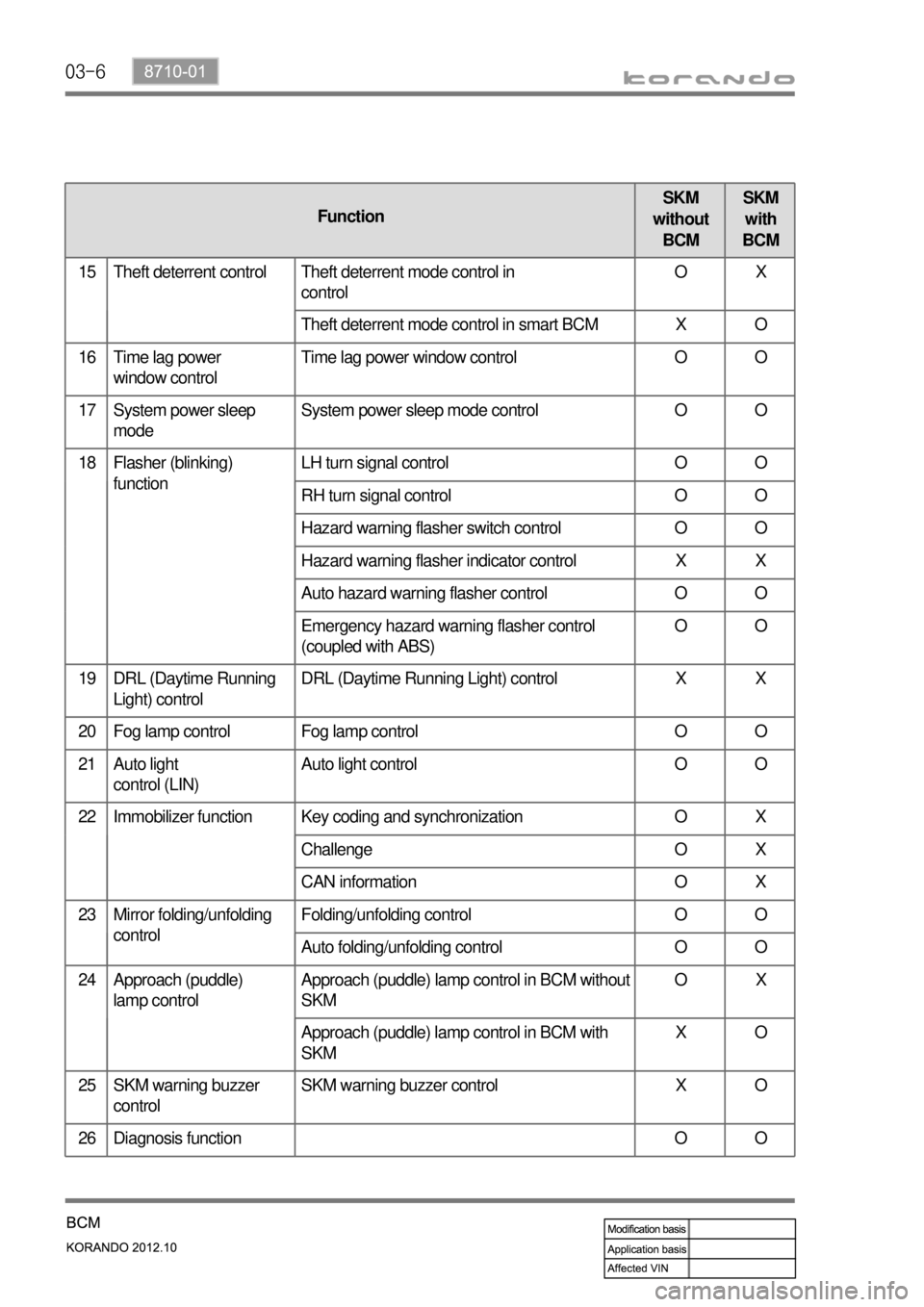2012 SSANGYONG KORANDO window
[x] Cancel search: windowPage 293 of 1082

15-170000-00
(3) Accelerometer Control
a. Resetting the pilot injection
The accelerometer is used to reset the pilot injection flow in closed loop for each injector. This method
allows the correction of any injector deviations over a period of time. The principle of use of the
accelerometer is based on the detection of the combustion noises.
The sensor is positioned in such a way as to receive the maximum signal for all the cylinders. The raw
signals from the accelerometer are processed to obtain a variable which quantifies the intensity of the
combustion. This variable, known as the ratio, consists of the ratio between the intensity of the
background noise and the combustion noise.
A first window is used to establish the background noise level of the accelerometer signal for each
cylinder. This window must therefore be positioned at a moment when there cannot be any
combustion.
The second window is used to measure the intensity of the pilot combustion. Its position is such that
only the combustion noises produced by the pilot injection are measured . It is therefore placed just
before the main injection. 1.
2.
The accelerometer does not allow any evaluation of the quantity injected. However, the pulse value will
be measured when the injector starts injection and this pulse value is called the MDP (Minimum Drive
Pulse). On the basis of this information, it is possible to efficiently correct the pilot flows. The pilot
injection resetting principle therefore consists of determining the MDP, in other words the pulse
corresponding to the start of the increase in value of the ratio (increase of vibration due to fuel
combustion).
Page 294 of 1082

15-18
This is done periodically under certain operating conditions. When the resetting is finished, the new
minimum pulse value replaces the value obtained during the previous resetting. The first MDP value is
provided by the C3I. Each resetting then allows the closed loop of the MDP to be updated according to
the deviation of the injector.
b. Detection of leaks in the cylinders
The accelerometer is also used to detect any injector which may have stuck open. The detection
principle is based on monitoring the ratio. If there is a leak in the cylinder, the accumulated fuel self-
ignites as soon as the temperature and pressure conditions are favorable (high engine speed, high load
and small leak).
This combustion is set off at about 20 degrees before TDC and before main injection.
The ratio therefore increases considerably in the detection window. It is this increase which allows the
leaks to be detected. The threshold beyond which a fault is signaled is a percentage of the maximum
possible value of the ratio.
Because of the severity of the recovery process (engine shut-down), the etection must be extremely
robust.
An increase in the ratio can be the consequence of various causes:
Pilot injection too much
Main combustion offset
Fuel leak in the cylinder -
-
-
If the ratio becomes too high, the strategy initially restricts the pilot injection flow and retards the main
injection. If the ratio remains high despite these interventions, this shows that a real leak is present, a
fault is signaled and the engine is shut down.
c. Detection of an accelerometer fault
This strategy permits the detection of a fault in the sensor or in the wiring loom connecting the sensor to
the ECU.
It is based on detection of the combustion. When the engine is idling, the detection window is set too low
for the combustion caused by the main injection. If the ratio increases, this shows that the accelerometer
is working properly, but otherwise a fault is signaled to indicate a sensor failure. The recovery modes
associated with this fault consist of inhibition of the pilot injection and discharge through the injectors.
Page 552 of 1082

02-14
Engine compartment fuse and relay box V (Ef17, Ef20~Ef23, Ef25~Ef26, WIPER MOTOR
RELAY(HI, LO), HORN RELAY, POWER WINDOW RELAY) ▶
Page 572 of 1082

03-6
FunctionSKM
without
BCMSKM
with
BCM
15 Theft deterrent control Theft deterrent mode control in
controlOX
Theft deterrent mode control in smart BCM X O
16 Time lag power
window controlTime lag power window control O O
17 System power sleep
modeSystem power sleep mode control O O
18 Flasher (blinking)
functionLH turn signal control O O
RH turn signal control O O
Hazard warning flasher switch control O O
Hazard warning flasher indicator control X X
Auto hazard warning flasher control O O
Emergency hazard warning flasher control
(coupled with ABS)OO
19 DRL (Daytime Running
Light) controlDRL (Daytime Running Light) control X X
20 Fog lamp control Fog lamp control O O
21 Auto light
control (LIN)Auto light control O O
22 Immobilizer function Key coding and synchronization O X
Challenge O X
CAN information O X
23 Mirror folding/unfolding
controlFolding/unfolding control O O
Auto folding/unfolding control O O
24 Approach (puddle)
lamp control
Approach (puddle) lamp control in BCM without
SKMOX
Approach (puddle) lamp control in BCM with
SKMXO
25 SKM warning buzzer
controlSKM warning buzzer control X O
26 Diagnosis function O O
Page 575 of 1082

03-98710-01
1. OVERVIEW & FUNCTIONS
BCM (Body Control Module) controls the electric equipment on car body and outputs the control and
warning signals as below.
List Function List Function
1 Wiper control 14 Tailgate open control
2 Ignition key reminder warning 15 Theft deterrent
3 Tail lamp control 16 Time lag power window control
4 Door ajar warning 17 System power sleep mode
5 Seat belt control 18 Flasher function
6 Sunroof warning 19 DRL (daytime running lamp) control
7 Room lamp control 20 Fog lamp control
8 Key hole illumination control 21 Auto light control (LIN)
9 Defogger control 22 Immobilizer function
10 Keyless entry function 23 Folding/unfolding function
11 Door lock/unlock control 24 Approach (puddle) lamp control
12 Panic alarm 25 SKM warning buzzer control
13 Headlamp control (escort) 26 Diagnosis function


